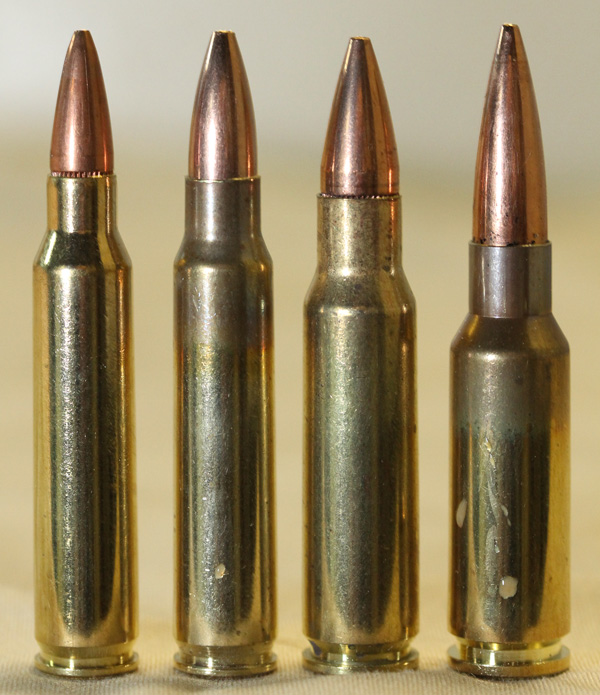
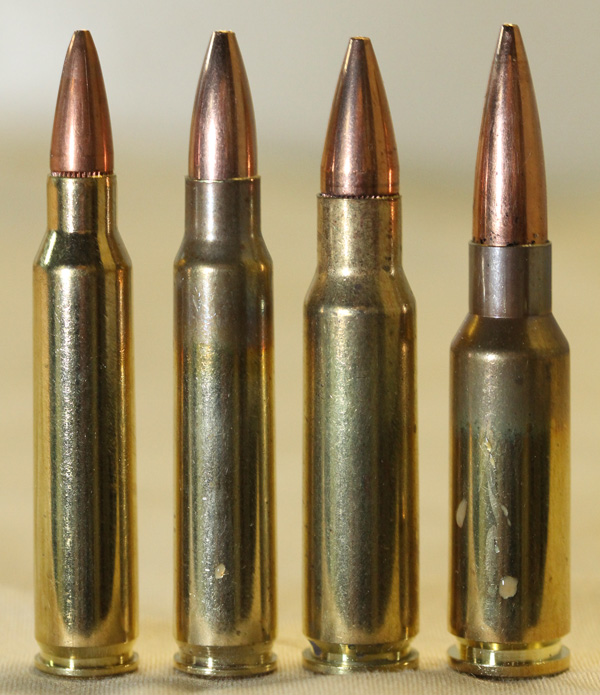
The original caliber for the AR-15 wasn’t the .223/5.56, it was a slightly smaller cartridge. The .222 Special delivered the kind of performance that the designers wanted, which was basically a 50-grain bullet at under 3,000 feet per second.
The Army, trying to keep the AR away and keep the M14 in the running, kept moving the goalposts. Finally, they insisted that the bullet used had to penetrate a steel helmet at a distance farther than their own research had indicated soldiers fired on opponents. The special got stretched and boosted, until the 55-grain FMJ was at 3,100 fps.
And there it stood, until the mid-1980s, when the SS109 came about. That was intended for use against swarms of Soviet infantry in Western Europe. What, there never were swarms of Soviet infantry in Western Europe? Musta worked.
Seriously, the expectation was that the Soviets would roll West, and the NATO allies would be faced with Russian, East German, Polish and who knows who else mechanized infantry piling out of their BMDs, BMPs, and BTRs, lining up and assaulting the NATO positions. They expected to face lots of targets, and not only armed ones, but armored infantry. So, the push was for armor-piercing performance, leading to the SS109 and the laterM-855, with a 10-grain steel penetrator tip inside.
The new rifle also received a new barrel twist, one turn in seven inches, to fully stabilize the SS109 and the tracer as well. Only the tracer really needed the new twist, but the military approach was/is a “one size fits all” approach, so there it was. I had a talk with Mark Westrom, CEO of Armalite about that, and here marked that it would cost more to prove to the Army that a 1:9 twist was better than it would cost to re-barrel every rifle in inventory to 1:9.
Fast-forward to Somalia, the infamous “Blackhawk down” incident. There, good shooters (Rangers, Special Forces and Delta operators) spent a long time, and a lot of ammo, shooting at people who in many instances didn’t fall down when hit. To everyone’s surprise, small bore ammo designed to penetrate to a fare-thee-well failed to do more than create simple perforation wounds on unarmored opponents.
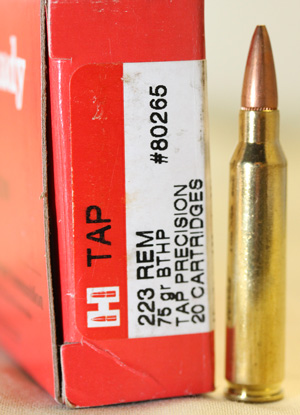 So the system stayed quiet until we were in another shooting war, and reports came back. This time, they came back too often, and too frequently, and over a long period of time, to be ignored. As a result, the now well-known Mk 262 load was developed. What it does is simple: It takes advantage of the too-fast twist of the M16A2 and M4, the 1:7 twist, and loads a 75- or 77-grain bulletin the case. The longer bullet is less stable than the shorter, 62-grain M855, and thus overturns on impact or soon after.
So the system stayed quiet until we were in another shooting war, and reports came back. This time, they came back too often, and too frequently, and over a long period of time, to be ignored. As a result, the now well-known Mk 262 load was developed. What it does is simple: It takes advantage of the too-fast twist of the M16A2 and M4, the 1:7 twist, and loads a 75- or 77-grain bulletin the case. The longer bullet is less stable than the shorter, 62-grain M855, and thus overturns on impact or soon after.
The next step was a refinement, the Mk 262 Mod 1, which included a cannelure in the bullet. The cannelure is a place to crimp the case neck into, but it also strategically weakens the bullet. When it begins to overturn on impact, it then breaks apart at the cannelure.
Stop wringing your hands. Lots of bullets overturn, tumble in the parlance, and lots of bullets have cannelures. And some have both, such as the old loading, the M-193, the 55-grain load from the Vietnam era.
The Mk 262 carries its speed better and offers longer-range performance. In fact, it offers too much long range performance, at least as far as hitting is concerned. You see, it puts the Army on the horns of a dilemma. The load is so accurate in some rifles that a skilled shooter can hit his target far beyond the effective ballistic “thump” of the bullet. Yes, a 77-grain bullet is gonna hurt, but when it has dropped to the performance of a .22 rimfire magnum, it gets tough to justify it.
What’s worse, not all (in fact, very few) of the soldiers who might get their hands on it can actually make use of its range. Yes, I’d rather poke a .224 hole through a bad guy at 700 yards, than let him walk off unscratched. The awful truth is, the Army doesn’t teach enough about marksmanship to let soldiers do that. The qualification course goes out to 300 meters.
There is no feedback, so if you nick the edge of the target you get scored the same as if you center-punched every one. Beyond 300 meters is a mystery, and many soldiers will be told to not shoot at the 300-meter targets, to save the rounds. That way, they can use the extras to make sure they get this close in. After all, with 20 targets coming up, and 20 rounds, you need only a dozen hits to pass. So, if the far targets are chancy, save your shots for the sure thing.
Which is a less than reassuring skill set to have, wedged behind a boulder in Afghanistan whilst being thrashed by a tripod-mounted PKM from 800 meters out.
No, the Army spends time teaching marksmanship skills to only a very few. They haven’t time, being too busy with a whole raft of mandated courses they have to teach first. But that doesn’t keep shooters from dreaming. The first dream was to stretch the existing round more. The longest-lasting and most-desired is to go back to the very beginning.
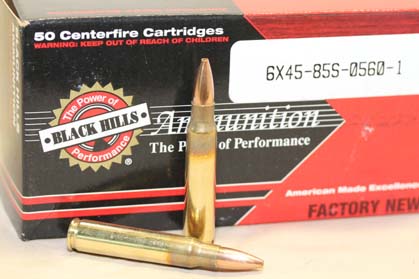
6X45
One of the first wildcats for the AR, and other rifles, it is a simple one to effect: basically take a .223 case with a neck not work-hardened too much and pop a 6mm neck expander stem through it. The result is a .223/5.56 case with a neck that will hold a .243-inch bullet instead of a .224-inch bullet.
As a deer-hunting round, this offers some prospects. In a bolt-action rifle, unless it is one scaled for the .223 and the .223 alone, you can gain useful case capacity by loading the bullet longer. The longer-loaded bullet doesn’t protrude into the case, and you end up with as much capacity as the .223 had.
However, we have not that luxury in the AR-15. The magazine dictates just how much length we have to work with, and no more. That, combined with the fixed location of the case mouth, means we cannot use a longer, more aerodynamic bullet to keep the speed up down range. It also limits the weight we can use, as a heavier bullet decreases case capacity (the room for powder) and thus gives us a double whammy in velocity loss: More weight and less powder.
However, improved powders have changed that somewhat since the 1960s, the last time anyone looked at the 6X45 in rifles.
The modern look is interesting, as it combines with the sudden increase in the AR, with a mild deer-capable cartridge. There are states that do not allow .22 rifles for deer hunting. However, a 6mm such as the 6X45 is allowed. So, a 6mm loaded with soft point bullets, say an 80-grain bullet at 2,800, is plenty good enough to drop a whitetail.
Now, since we can’t always depend on the velocity printed on the box, and a lot of ARs for hunting would be handier, in a 16-inch-barreled carbine, we’d be talking more like 2,650, but that is still good enough to drop any whitetail who ever walked the American continent, given a well-placed shot.
The 6X45 has been around since at least 1965 as a recognized wildcat. In all that time, it didn’t get much traction. Why does it now? Two things: new powders and new bullets. In 1965, if you could push an 85-grain bullet much past 2600 fps, you were doing great. And the bullet so-pushed was a plain old “cup and core” softpoint, with not much ability to retain weight or shape and penetration.
Now, we have powders that can push the same weight at 2800 fps, a more useful velocity. And the bullets being pushed, bonded-core softpoints, all-copper hollowpoints, will retain weight, penetrate and work like they are much bigger bullets than they are. At the other extreme, varmint bullets are much better than they were in 1965. They are more accurate, fragile, and able to be pushed to higher velocities. If you want warp speed, a Hornady VMax of 58grains loaded to 2950 fps is your choice, and if you want a bit more range even if it means giving up 75 fps, then their 65-grain VMax at 2875 fps will vaporize varmints at distance.
All of which makes the 6X45 a much more attractive hunting/varmint cartridge than it used to be. However, there are some touting it as a replacement for the 5.56 as a defensive load. There, I have to part company with them. The 6X45 as a deer cartridge works well because of the new generation of expanding bullets. In a military context, expanding bullets aren’t allowed. Yes, police and non-sworn taxpayers can use expanding bullets, but the fewer offerings in the 6X45 make it less useful. I know, I know, it’s like the getting-your-first-job conundrum: You have to have experience to get a job, but if you haven’t had a job, how are you going to get experience?
If people don’t buy the 6X45 for defense, how can they expect the ammo makers to load defensive ammo for it? Not my problem.
The 5.56 gets around the “no expanding bullets” problem by using long-for-their-weight bullets that tumble and break. The 6X45 is boxed in in that regard. Any bullet you can push fast enough to break up is too short to be broken. And any bullet long enough to be breakable is too heavy to push to a speed where it breaks.
The pilots among us will talk of the “performance envelope” which is a graph of speed and altitude, turning radius, range, etc. Operating “in the corner” or “on the edge” means going right up to the limit. The U-2 worked that way. It traveled so high, where the air was so thin, and so close to the limits of its ability, that pilots could not make turns that were too tight. To do so would mean the wingtip of the inside wing (the wings were very long for its size) would slow down, and fall below the stall speed of the aircraft. The sudden drag of the stalling wingtip would put the U-2in a flat spin, which was usually not something the pilot could recover from.
The 5.56 is operating in a corner of its performance envelope: there is just enough room to push a 75- or 77-grain bullet fast enough to make it break up when it tumbles. The 6X45 does not have that room.
So for the military it isn’t a viable option. But for hunters and the non-military defensive user, it offers many advantages. And the biggest of those is that to convert a rifle to 6X45, you need only a new barrel. The bolt and magazines of your 5.56 will work just fine, thank you very much.
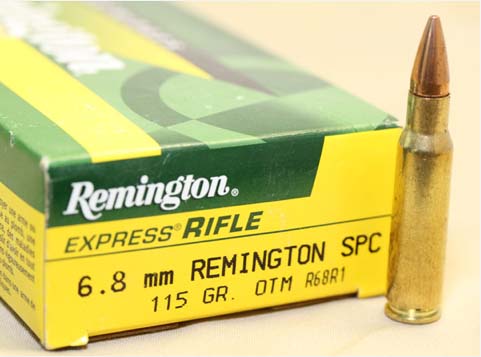
6.8 Remington SPC
The “six point eight” erupted on the scene as the replacement for the “anemic” 5.56. The idea was to use a case with more volume than the 5.56, but not one that required a wholesale redesign of the rifle. The case settled on was the old .30 Remington, with some changes.
Now, this is not anything new. Back in the mid-1980s, I was fiddling around with new designs. One I came up with was a 25mm grenade for a self-loading grenade launcher, for use in the military. I wanted to come up with something besides the single-shot M79, or the bulky and awkward M203.
So, I did some thinking, made some drawings and turned sample cartridges out of aluminum rod. However, lacking both a loading lab to make sample test shells for further experimentation, and the licenses to do such work, I had to leave it at drawings and solid-aluminum dummies. However, while I was doing that I happened to have not one, but two customers’ rifles chambered in .30 Remington come through for work.
In the course of repair and test-fire, I had to track down some .30 Remington ammo. As I was looking as the ammo, I happened to have a 20-round AR magazine nearby. Just out of curiosity, I snapped the loaded round into the magazine. Hmmm, pretty close, but too long. I figured I could make changes, and perhaps even re-barrel a rifle. A glance at my elderly lathe made it clear I had not the equipment to hold the tolerances to turn down a barrel or barrel blank and fit it to an AR.
There was also the matter of timing. Back then, no one would have been interested in a replacement cartridge for an AR that didn’t do what a .308 did. If I couldn’t make “Major” there was no point to the experiment. The .30 Rem Short (as I had mentally named it then) had no chance of being boosted to Major, not with the powders we had back then. So I shelved the idea. Now, I make no claim to being first, only or the cleverest on that subject. I’m just pointing out that it is durned difficult to come up with something that is truly new.
The 6.8 was not meant to make Major. It was meant to produce the most “oomph” out of an M4 carbine, with the least amount of modification to the package, and the most commonality with existing gear. As such, it requires a new barrel, a new bolt (which is essentially the old bolt with a bigger bolt face) and new magazines.
The original plan, I’m sure, was to make it work in existing magazines. Well, that just couldn’t happen. What I am sure of is that if you were willing to invest enough computer simulation time, you could come up with a 6.8-ish cartridge that stacked and fed from unmodified AR magazines. I’m also sure that by the time you got done modifying the cartridge case to permit such feeding, you’d have lost enough case capacity that you didn’t have performance any better than the 6X45.
So, the 6.8 got new magazines. And what is the performance that makes new bolt, barrel and mags worth it? At the low end of weight, we’re talking a 90-grain JHP at 2800 fps. Moving up, the “sweet spot” seems to be in the 110 grain range, where a 110 JHP or OTMcan be pushed just short of 2600 fps. Now, for those who are accustomed to a screamer 5.56 load like the XM-193 (a 55-grain FMJ at 3200 fps) or the Mk 262 Mod 1 (a 75- or 77-grainer at 2800 fps) the 6.8 may not seem like much. But with the 6.8 we get back that corner of the performance envelope that the 6X45 gave up. You’re now pushing a heavy bullet fast enough that it will upset, or, when it tumbles, does good work moving sideways.
Now, as with the .223 vs. the 5.56, there is the original, and the later 6.8. The original was designed as a collaboration between the Special Forces NCOs who had the idea and the Remington engineers who did the detail work, drawings, etc. The .223 differs from the 5.56 in that the lead-in to the rifling on the .223 is shorter and steeper than it is on the 5.56. The reasons are thus: the .223 is meant as a varmint cartridge, and there accuracy is prized over all else. The 5.56 is a combat cartridge, and reliability and pressure control are prized. So, the longer freebore and gentler leade of the 5.56 allows for heavy bullets (like tracers) and for a dirtier operating environment.
The original 6.8 was designed more along the lines of the .223. Soon after, experimenters changed it. They lengthened the freebore and the leade angle was made more gentle, plus one more change; rifling twist. The original twist is/was 1:10; the new uses a 1:11 twist. With a greater freebore, gentle leade and slower twist, the 6.8 II is better able to handle pressure than the older design. It also makes the bullets just a bit closer to unstable, although still accurate, and this enhances terminal ballistics. Well, with all that, the government didn’t adopt the 6.8. In fact, the NCOs who pushed it got into hot water.
You see, good ideas are valued by large organizations as long as good ideas come as a result of the system. Good ideas that are not a result of the system are heretical and must be quashed.
Is the 6.8 a good idea? You bet. As long as you are willing to make the investment in the new gear, it is a very good idea. Magazines are now readily available from CProducts, PRI and others. One you won’t see, or so the guys there tell me, are PMags in 6.8. The fatter cartridge just won’t stack properly inside a magazine tube made of polymer. At least, not with the thickness needed for durability. Sure, they could make it thinner, but who wants a fragile polymer magazine?
Magazines fit in mag pouches, reloading presses work on 6.8 just as they do any other cartridge, and the bullet diameter is a common one, so no problem there.
In all fairness, one big problem for the military is how much commonality there it. For us, the fact that it is all so close is a big advantage. For the military, it’s a big disadvantage. You see, you can load 6.8 in regular mags. Or you can load 5.56 in 6.8 mags. And either will fit in the other’s mag well. I haven’t seen a 6.8 try to digest a 5.56, but I’ve seen a 5.56 try to chamber a 6.8. So, if the military is going to adopt it, they have to make a clean sweep.
So, if they want to try the 6.8, to see how it works, they have to make sure that the troops going into Carjackistan are all armed with 6.8s and nothing but 6.8s. and anyone who comes to support them must have 6.8s. The supply system has to be hyper-vigilant about ammo, otherwise a chopper will arrive at a dusty FOB, kick out a pallet of crated ammo, and take off before the locals get a chance to have a go with their RPGs. And the troops will find the ammo is 5.56, not usable in their 6.8 rifles.
Worse yet, the Army can’t just re-barrel existing M16/M4s. The system isn’t set up to allow a rifle, M16A-whatever, clearly marked on the receiver as a 5.56, to be chambered in anything else. There would have to be, at the very least, a new designation, and the altered rifles so marked. It would be better if they were new ones, cosmetically modified in some way to make them clearly different.
For the military, changing to 6.8 is not a “bolts, barrels and magazines” change, but a billion-dollar cost. For what? A bit more terminal effectiveness? That’s what radios and artillery are for.
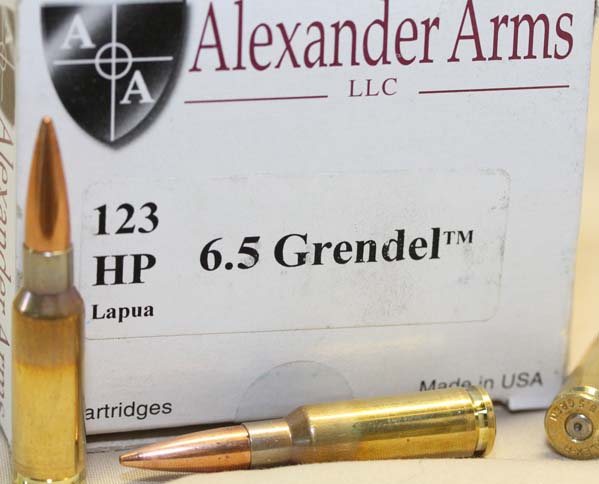
6.5 Grendel
Unlike the 6.8, the 6.5 came from the fertile mind of an inventing genius who wasn’t trying to invent a better jihadhi-busting round. Bill Alexander is one of those guys who can’t look at a part, mechanism, cartridge or other design without thinking of ways to improve it. The 6.5 Grendel is a simple-appearing cartridge. To define it in the simplest and most Bill-discounting terms, it is a 6.5/7.62X39 Ackley Improved. That is, it is the Soviet 7.62X39 case, necked down to 6.5, and with the shoulder blown out and sharpened, and the case walls straightened.
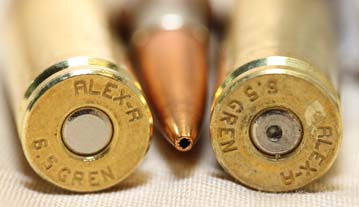
Which grossly diminishes the work necessary to refine the dimensions of each. To give you one example, the case neck: how long? A shorter neck means a more-forward shoulder, and thus greater case capacity. More capacity means more powder, leading to more velocity, and greater range.
However, a shorter neck also means a less-pointy bullet, and thus a lower ballistic coefficient, leading to velocity drop at range. A shorter neck also means less tension on the bullet, and a greater likelihood of bullets loosening on feeding (being rudely shoved up the feed ramp) and a blown case from bullet setback. Some like to compare the 6.5 to the 6.8, and start an argument as to which is “best.”
They are more alike than they are different, despite the cases being so different. The two each start bullets in roughly the same velocity range, with bullets of similar weight, and the close-in performance is similar. (And both sides will hate me for saying so.)
The difference is in the long-range performance. A 6.8 bullet of 110 grains that starts at 2550 fps reaches the 500-yard line with 1515 fps and the 1,000-yard line with 980. A 6.5 Grendel, launching a 123-grain Lapua Scenar at 2650 fps, reaches the 500-yardline with 1890 fps and the 1,000 yard line with 1304 fps still on board.
For pretty much the same shoulder-thump, you get far better downrange performance, once you exceed the “typical combat” ranges of 300 meters.

The 6.5 Grendel requires the same parts be exchanged to create it as the 6.8: bolt, barrel and magazines, although none of the three is cross-compatible between the 6.5 and 6.8. You pick one or the other, not something that does both.
Starting out, Bill Alexander patented and trademarked the cartridge and components, because the performance and accuracy were the big advantages of the system over other calibers. To devise something that performed and then allow anyone who wished to, to make one, and potentially diminish its performance and reputation,was not what he wanted. He has since licensed the round and designs to others.
Do you need a 6.5 (and when has need ever entered into the discussion)? Well, if you want to do long-range precision work, and don’t want the bulk and thump of the .308 in an AR-10 type rifle, yes. You can shoot to distance with a 5.56; the NRA High Power ranges have proven that. However, at 600 yards the 5.56 is not exactly the hammer of Thor. If you want to reach out and have some tap left, then the 6.5 is the next step up.
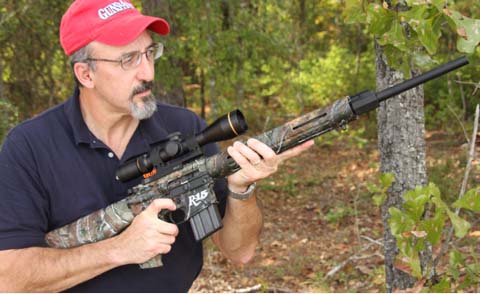
.30 Gremlin
Ok, just to go full circle, at the USPSA 2009 Multi-gun Championships, the USAMTU shooting team arrived with yet another new cartridge. First: Multi-gun? In the early days of 3-gun competition, we simply slapped together a match by putting up a handgun stage, a rifle stage and a shotgun stage. Later, we expanded by having multiple stages for each discipline. Well, that wasn’t adrenaline-inducing enough for some, so the stages got combined. In a Multi-gun match, you’ll have stages that require you use two or all three of the guns. Use a handgun to shoot the close targets, shoot empty or unload, pick up your rifle and shoot the far targets. That sort of thing.

The .30 Gremlin is the 6.5 Grendel necked up to .308, loaded with 125-grain bullets and boosted to make Major. All of a sudden,we have a .30 Major round that fits a standard AR-15 platform and doesn’t have to be chambered in an AR-10-sized rifle. Of course, the drawbacks are severe, and thus probably limited to competition, but you have to admire the ingenuity. Limiting it to a 125-grainbullet means no tumbling and no fragmentation. Of course, it is still a .308-inch bullet at Major, and as such a big step above the 7.62X39, which has always been the exemplar against which the 5.56 has been proven to “fail.”
Capacity is exactly the same as he 6.5 Grendel, and the Gremlinuses Grendel magazines.
Does this round have a future? Sure, as a competition round. For those who wish to shoot 3-gun or Multi-gun matches and want to shoot Major without going to a full-sized AR-10 based rifle or some other platform, it holds promise. Other than that, I doubt it.
30 Remington AR
The 30 Remington AR makes Major, too, but goes about it in a different manner. Starting with the case from the .450 Bushmaster, Remington necked it down to .308-inch, shortened it, and altered the rim diameter to make it non-compatible with .450 Bushmaster bolts and thus preclude someone from cobbling together a .30 Remington AR out of spare parts. The resulting cartridge feeds from an AR magazine, but it stacks singly, not staggered.
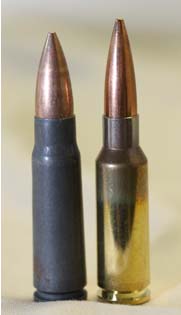
As a result, capacity is greatly reduced in the magazines, but that isn’t a problem Remington cares about. You see, the idea was to make the rifle a suitable deer hunting rifle, and one in .30 caliber, a bore size desired by many deer hunters.
The result is a case with the internal capacity of a .30-30, but since it operates at a higher chamber pressure than that lever gun cartridge, the .30 Rem AR offers greater velocity. Also, being magazine-fed, it uses pointed bullets instead of flatpoints or roundnose bullets like the .30-30.
For tactical or defensive use, the round offers nothing of interest. Capacity is low, performance is in an odd niche of weight and velocity, and the bullets aren’t of interest to the tacti-cool crowd. What it does, however, it does brilliantly: it offers the deer hunter who isn’t interested in tactical black guns a self-loading hunting rifle of more than deer-hunting performance, and what’s more, such a rifle comes from a maker who has no previous history in military guns. (At least not from the point of view of the deer-hunting crowd.)
If you show up in deer camp with an AR made by a big name military or tactical/defensive company, you’ll get stared at. But, the same rifle, with the name “Remington” on it, brings instant acceptance. Or, at the very least, cloaks you in respectability as you argue the virtues around the wood stove before Opening Day.
The rest of us? An interesting curiosity. Oh, when I first heard of the round, it was at a Remington seminar, and my question was “Aren’t you worried about shooters confusing it with the old .30 Remington round?”
The answer was no, they weren’t. They didn’t feel there were enough shooters who remembered it to cause a problem. So far, it seems they were right. A shame, since the old .30 Remington, in the Remington Models 8/81 and 14/141, was a very reliable deer-busting round – and a brainchild of the great John M. Browning, no less. To be so forgotten, by the very inventors of it…oh, the indignity!

Next Step: Get your FREE Printable Target Pack
Enhance your shooting precision with our 62 MOA Targets, perfect for rifles and handguns. Crafted in collaboration with Storm Tactical for accuracy and versatility.
Subscribe to the Gun Digest email newsletter and get your downloadable target pack sent straight to your inbox. Stay updated with the latest firearms info in the industry.

![Best Concealed Carry Guns In 2025 [Field Tested] Wilson Combat EDC X9S 1](https://gundigest.com/wp-content/uploads/Wilson-Combat-EDC-X9S-1-324x160.jpg)


![Best 9mm Carbine: Affordable PCCs [Tested] Ruger Carbine Shooting](https://gundigest.com/wp-content/uploads/Ruger-Carbine-Shooting-100x70.jpg)
![Best AR-15: Top Options Available Today [Field Tested] Harrington and Richardson PSA XM177E2 feature](https://gundigest.com/wp-content/uploads/Harrington-and-Richardson-PSA-XM177E2-feature-100x70.jpg)

I can’t figure out what the grenade launcher story has to do with anything here… it seems to be stuck in there very awkwardly.
A lot of space given to the 6X45mm. One was sort of forced on me back in the 1980’s, and I quickly decided it offered nothing of interest. Maybe you can gain a measly 10 grains of bullet weight compared to the standard .223, say 85 grains vs. 75 grains, both loaded to fit in the AR-15 magazine, and if you’re lucky maybe the BC will remain about the same. I guess bullets and powders have improved some over the years, but not enough to make the 6X45mm of any interest to me. I want to shoot bullets of 100 grains or more, with a G1 BC over .500, as the 6mm ARC (or maybe 24 Nosler?) now does. That is different enough to make it worthwhile.
I like the 6.8 SPC, but really for home defense you should be using a shotgun. Or if you must use an AR then just buy a box of hollowpoint varmint rounds with frangible bullets and you will have increased stopping power plus be somewhat less likely to shoot through walls and kill your next-door neighbor.
Then there is the 6.8 SPC that delivers 90gr to 120gr bullets designed and engineered right to deliver 2 times the wound cavity of the 5.56 green tips and 77gr bullets. At 300yds and under it kills with authority with little recoil at 80% power of a 308 Win. But, since big industry did not design it in a research lab of their own, they let it die except for Hornady who was involved in the beginning.
Lets look at this:
1. Remington wouldn’t keep the 450 bushmaster case making it- special and they own everthing.
2. Remington didn’t advertise it or market at all
3. A 30-30 can do what this does with a 20″ barrel / AK47 7.62×39 does 3/4 of it at $5 a box
4. It has a 22″ barrel and costs $1000+ and then no reloading brass was released
5. If it was necked down to 6.5mm it would be a winner, since it isn’t, it is a loser.
Anyway you look at it Remington engineered a paperweight due to not releasing brass, etc.
Remington gets an C+ for engineering and F+ for supporting and marketing it.
If Remington had necked it down to 270 (0.277) to take advantage of all the 270 Win bullets or 6.5mm to take advantage of the 123 Amax and others Win/Win. Those calibers kill deer too and short and long range. But since Remington put their D team on it, it flopped miserably compared to just buying a 30 -30 Win with ammo for $300 from Chinamart and kill deer and hogs fine at 200yds and under – blue collar working man’s rifle. Even a bolt action Rem 700 ADL costs $350 and will kill with more fps and better hunting bullet selection at 1/3 the cost of the 30 Rem AR.
Remington designed a much stronger bolt/barrel extension combination for the .30 AR and had to make sure nobody built a .30 AR using the .450 Bushmaster type bolt which would be too weak for the backthrust generated. It was a safety thing, not just tripping people up for the heck of it. The .450 Bushmaster has a bigger rim than even the 6.5 Grendel, so the bolt face is cut bigger and the locking lugs are weakened more. That is OK for the .450 Bushmaster, as it operates at a much lower PSI, but it would not be OK for the .30 Remington AR.
The gun/ammo companies do some strange stuff. The .30 TC cartridge comes to mind; it was sort of a technology demonstration for nerds rather than something that might actually catch on and sell. Then there was the rimmed 9mm Federal cartridge. And the whole line of Remington Short-Action Ultra Magnums, starting out after Winchester had already captured (and eventually over-saturated) the short magnum field. I’m not sure what the popularity status of that Winchester .17 super magnum rimfire is now… but it has the additional risk of being a non-reloadable rimfire. I think the 7-30 Waters cartridge suffered from being too conservative in design; if it had appeared a bit more radical and exciting it might have had a chance, say with a smaller .270 bullet and an “Ackley improved” style case.
I rather liked the .450 Marlin, but wow it seems totally dead now. Nobody has brass, and it looks like nobody plans to produce any. It actually seemed like a good idea to me, and would be kinda fun in a short bolt action carbine.
There are a few other good AR15 rounds out there as well. As ‘theken101’ mentioned above, there is the .300 AAC Blackout which, if I’m not mistaken, is little more than a renamed & SAAMI approved version of the much older .300 Whisper wildcat round. Either one when loaded with a 110gr-115gr bullet basically replicates the ballistics of the 7.62x39mm round in a cartridge that is far more compatible with the AR15 platform, requiring only a new barrel.
For the varmint hunters out there the .204 Ruger is a superb cartridge for sniping ground squirrels & prairie dogs, and, like the .300 Blackout, requires only a new barrel to work in an AR15. It’ll spit out a 32gr bullet at over 4,000fps and excels at exploding those prairie destroying little rodents at long range (as long as you can deal with the wind).
One of the new cartridges that I find very interesting comes from Olympic Arms and was designed to exceed .308 Winchester ballistics in the AR15 platform. They call it the .300OSSM–Olympic Super Short Magnum–and it is essentially a Winchester Super Short Magnum case necked up to .30 caliber. Though magazine capacity is low, the cartridge holds a lot of promise for hunting & long range shooting with the AR15 platform.
Then of course there’s the true big bores: the .450 Bushmaster, .458 Socom & .50 Beowulf. Any of the three will take any animal that walks on the North American continent, and they make dandy hog hunting rounds!
My personal favorites are the .223/5.56, the 6.5 Grendel & the .458 Socom. The .300OSSM has also peaked my interest!
Gimme my old M-14 any day. When the M-16 came at we called it the Mattel Special cause it looked like a toy gun from “Lost in Space.”
And no mention of the .300 AAC Blackout?